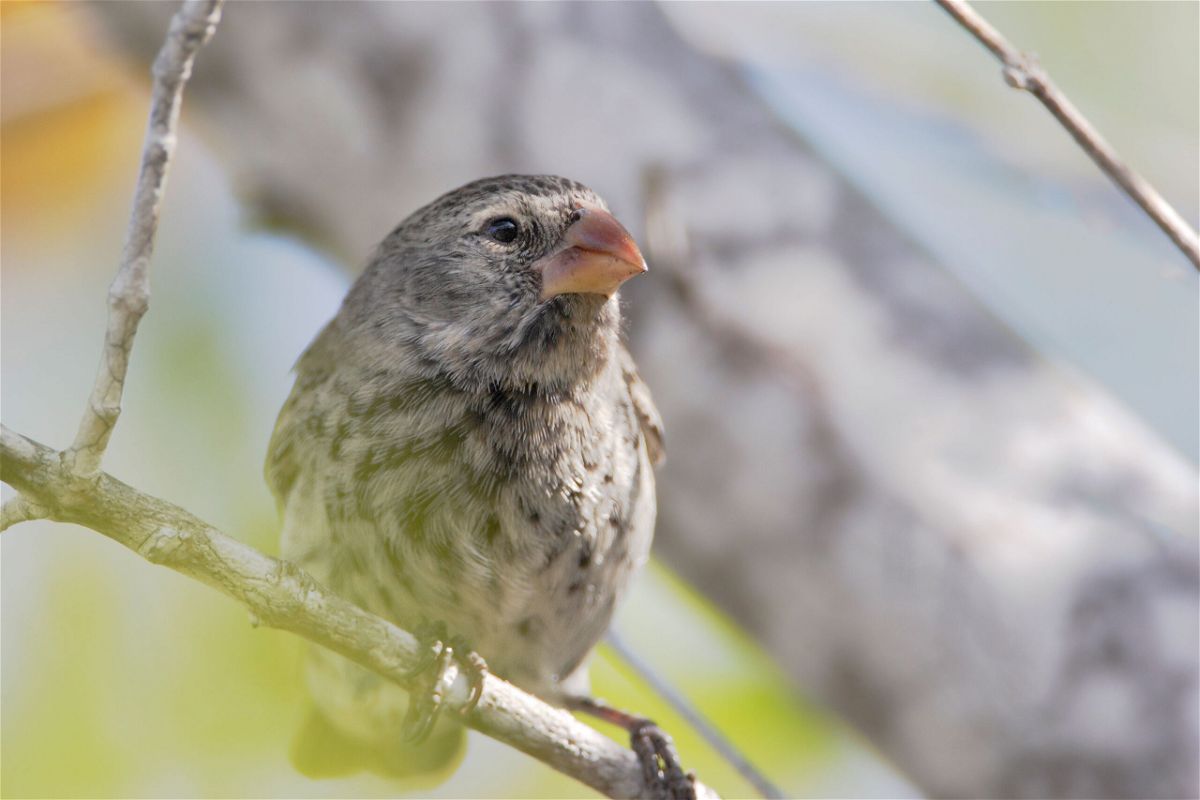Meet the man who has transformed our understanding of evolution

The small ground finch (Geospiza fuliginosa)
By Katie Hunt, CNN
On the Galapagos Islands, a ground finch that usually munched on small, soft seeds was forced, during a drought, to eat harder, larger ones.
Within the space of a few generations, the bird evolved a larger but shorter beak better suited to cracking large seeds.
The ground finch is one of at least 15 species of Galapagos finch descended from a common ancestor that flew in one fateful day about 2 million years ago, perhaps blown off course from South or Central America.
Another finch uses twigs or cactus spines to dislodge and snack on insects, while another, nicknamed the vampire finch, has evolved an especially sharp beak that allows it to peck at seabirds and feed on their blood.
“A bunch of species all descended from the single ancestor have proliferated so there are many species now. And they’re all doing different things,” said Dolph Schluter, a professor of zoology at the University of British Columbia in Canada, who began studying the finches in the late 1970s.
“For the most part, they are exploiting the environment in different ways. There are big beaks and small beaks. There are sharp beaks and dull ones.”
The Royal Swedish Academy of Sciences has awarded Schluter the prestigious Crafoord Prize for his work on the mechanics of evolution, which has fundamentally changed our understanding of how the tree of life branches out. The award is considered a complement — and for some winners, a precursor to — a Nobel Prize.
Instructive role
With their isolation and rich biodiversity, the Galapagos Islands have long served as a living laboratory for understanding evolution — and the finches have played an illuminating role in the history of life on our planet.
These bird species, along with other animals on the islands, inspired Charles Darwin’s theory of evolution and, 150 years later, allowed Schluter to demonstrate that Darwin’s theories about natural selection are true in practice.
For Darwin, evolution was largely a thought experiment inspired by what he saw in nature, but Schluter’s work, in the field and in the lab, has revealed and fleshed out the ecological mechanisms that drive the creation of new species.
In the Galapagos, Schluter found that when two finch species coexist on the same island, the differences in beak size and shape are more dramatic than when the same two species were found separately on different islands.
To Schluter, this phenomenon signaled that competitive interaction between the birds was a mechanism that led to the formation of new species.
“I was especially interested in … how competitive interactions — competition for food — caused them to become much more different than they would otherwise have been,” Schluter said. “And this seems to be a common explanation for the diversity of forms.”
This finding contradicted the received wisdom at the time that a new species would not arise if the existing population was still in contact and exchanging genes.
Before Schluter’s observations of the Galapagos finches, evolutionary biologists thought new species predominantly arose through isolation — when one population became geographically separated from another and because of this isolation accumulated genetic changes through chance mutations.
“Evolutionary biologists were much more focused and interested in the genetic mechanism. They missed what was going on in nature,” said Kerstin Johannesson, a professor of marine ecology at the University of Gothenburg in Sweden and member of the Royal Swedish Academy of Sciences.
“With really elegant experiments and very clever analytical tools, Dolph, more or less convinced all of us that this (ecology) was really the center of this process.”
The explosive evolution of one population into a multitude of new species is known as adaptive radiation, and some view Schluter’s 2000 book, “The Ecology of Adaptive Radiation,” as one of the most important on evolution since Darwin’s “Origin of the Species.”
Humble fish
While Schluter launched his scientific career with the famed Galapagos finches, he turned to the humble stickleback fish to further test his ideas.
A relatively young species, this fish primarily lives in the ocean but migrates to freshwater lakes to breed. Sometimes it can get stranded in lakes and evolve into a permanent resident of fresh water.
Schluter used this feature to his advantage, digging 13 ponds (now 20), each a bit larger than a basketball court, at the south campus of the University of British Columbia. He and his team used the ponds, acting as island analogs, to investigate how sticklebacks adapted to a freshwater environment and acquired different traits.
Gradually, differences emerged between the fish in the same lake — some lived at the bottom, while others preferred the open, free water. After generations of adaption to the different habitats over a matter of years, the differences were such that the two types no longer mated.
With colleagues, he’s also uncovered the genetic underpinnings of these changes in the stickleback fish.
Johannesson said that Schluter’s work could help scientists understand how the natural world might change in response to the climate crisis.
“In the ponds, he could see that evolution was really fast. Of course, this kind of evolution does not wait for new mutations but works on the variation that is already present in the population,” she said in a video produced by the Royal Swedish Academy of Sciences.
“This has relevance, especially now, when the climate is changing. Because we need to know how species can adapt to a changing climate.”
The-CNN-Wire
™ & © 2023 Cable News Network, Inc., a Warner Bros. Discovery Company. All rights reserved.
